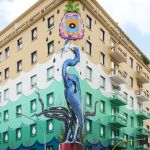
Hunting Pollution: the Roman mural that will save the environment
Thanks to special smog-eaten paints, it will purify the city's air as a forest of thirty trees
October 29th, 2018
If, as Dostoevsky said, beauty will save the world, graffiti art will save our lungs.
In Rome, in fact, in the Ostiense area, on a building at the intersection of Via del Porto Fluviale and Via delle Conce, the largest green mural in Europe has just been inaugurated. It is called Hunting Pollution, occupies 1000 square meters and is a five-story tall heron that hunts its prey in a polluted sea, designed by Federico Massa, aka "Iena Cruz", Milanese street artist internationally renowned for years dealing with the themes of environmental pollution, global warming and endangered species. The value of the work is strongly symbolic: the animal, in fact, not only hunts its prey, but also the pollution in one of the most trafficked and polluted intersections of the capital thanks to the use of eco-paintings.
The project from an idea by Veronica De Angelis, head of the non-profit company Yourban2030, which deals with environmental sustainability and art, is made with special paints that will purify the air of the city as a forest of thirty trees thanks to Airlite, a special painting made in Italy based on water, antibacterial and antismog, able to break down the levels of nitrogen oxides emitted by cars. This technology exploits the energy of light that acts in a manner very similar to that of chlorophyll photosynthesis in plants, generating a reaction through which pollutants are captured and destroyed, so that twelve square meters painted with Airlite can absorb the harmful substances produced from a car in a day. Rome thus becomes the capital of regenerative street art, applying to take on a leading role among European capitals in the reduction of nitrogen oxides, the most poisonous gases emitted from city traffic. One question remains: why not use smog-eating paints, not only for artistic projects, but also for construction? This should be the future of our cities, if it is true that according to the OMS 2018 data, 9 out of 10 people are exposed to levels of air pollution that are hazardous to health, responsible for millions of premature deaths each year.





























































